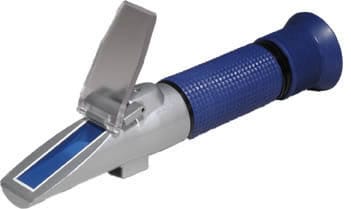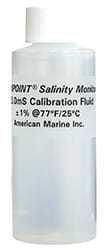The saltwater fish hobby is difficult enough as it is, but one of the most basic tools often leads to accidental livestock loss. A Hydrometer is a tool that measures the salinity or specific gravity of saltwater. Unfortunately, hydrometers are relatively inaccurate at measuring salinity.
Why Hydrometers Are Inaccurate
1. Hydrometers get bumped around during shipping from the manufacturer to the retailer. This can throw off the plastic swing arm and lead to false highs or lows.
2. After many uses, salt begins to build up in the hydrometer leading to false highs. This can be avoided by rinsing your hydrometer thoroughly after every use, but few hobbyists remember to.
3. Most hydrometers are calibrated to measure salinity at 70 degree Fahrenheit, but most hobbyists run their aquariums between 74 and 82 degrees. As temperature increases, so does salinity. Most hydrometers do not have built in automatic temperature compensation. As a result, the hydrometer reads a false low.
4. User error. Sometimes the hydrometer is misread by the user because little bubbles form on the bottom of the swing arm, which leads to false highs. You can knock off the little bubbles by gently tapping the swing arm with the end of a toothbrush.
As you can see, there are many things that can go wrong with a hydrometer that may cause false highs or lows. Instead, consider initially purchasing or replacing your hydrometer with a Refractometer. A Refractometer is a precision tool used to measure salinity. It does cost a little bit more, but it’s worth it in the long run.

Why You Need An Aquarium Refractometer
1. Most Refractometers cost $50 and the average hydrometer costs $10, so a difference of $40, or the cost of one or two fish.
2. When you use a hydrometer, you have no idea what your specific gravity is. It could be plus or minus .005. Natural seawater has a specific gravity of 1.025, so you set your aquarium’s specific gravity to 1.025 using your hydrometer. Unfortunately, your hydrometer is giving you false lows and your true specific gravity is 1.030. So you go out and buy two new fish and them to your aquarium. They still seem stressed hours later and the next morning they are dead. Now you are out $40 and still need to buy a Refractometer.
3. Here is another example. You know the fish store runs their specific gravity at 1.020 to help prevent fish parasites, so you decide to do the same. Unfortunately your hydrometer is giving you false highs and your true specific gravity is 1.015. So you go out and buy a new cleaner shrimp and some snails and acclimate them to your aquarium. A few hours later the cleaner shrimp and snails are dead. And again you are out $40 and still need to buy a Refractometer.
Can you see how any hobbyist could easily become frustrated and think they were doing something wrong, when their problems were actually caused by poor equipment. As you can see, a Refractometer will pay for itself after only a few uses.
1. When shopping for a Refractometer, make sure to purchase a unit with ATC (Automatic Temperature Compensation), so whether you mix your water at 60 degrees or 78 degrees it will take your water’s temperature into consideration.

2. You will also need Salinity Reference or Calibration Fluid. This fluid typically has a salinity of 35ppt or a specific gravity of 1.026. Use a Calibration solution rather than Reverse Osmosis water because it is has salinity closer to the standard aquarium specific gravity.
3. To use a Refractometer, place a few drops of water on the prism glass and hold it up to the light. Your aquarium’s salinity is where the boundary line of the blue and white intersect on the scale. Do not hold the Refractometer up to Actinic Blue Light, as it will be difficult to read.
4. To clean, simply wipe the prism glass dry and rinse the eye dropper.
In summary, a Refractometer is worth its weight in gold. When properly calibrated, it will reduce and prevent livestock loss, saving you money and frustration.
